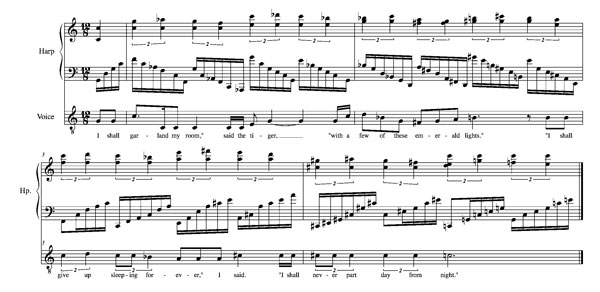So I’ve been going back over and over and over the four measures I wrote on Thursday for “Milky Way,” and I’m increasingly dissatisfied with them.
The germ of what I want is there. I’ve structured the piece in a quasi-sonata allegro form, and this is the B theme:
(You can click on it to hear it.)
That pattern of duple notes in the third measure has been used enough in the piece by the time we hit the climax to be a motif the audience would recognize. So what I wanted was to take that pattern and build it on top of itself to keep expanding out and out and out.
I think in the short term, I’ve done that. But here’s what I’m unhappy with. I think it’s too rushed. As Kevin pointed out in Lacuna when I played through the entire work for everyone, its origins as a song cycle betrayed itself in that there’s no time for stage action built into the pieces. I’m still fighting against that here.
I find myself compelled by the poem itself to keep the rhymes together so that the audience gets the full impact of Willard’s writing: lights/night. But musically (and stage-wise), I need more space between the tiger and the child’s statements. I think what I must do is go back and take some of the “build” out of the tiger’s part, and begin the actual building effect with a passage between the two, and even stretch out the child’s statements through a bigger build.
Yep, that’s what I need to do all right. Now let’s see if I can actually accomplish this.


On the other hand, it could be orchestration. If I were to divide the duple notes pattern between sections of the orchestra, it might not sound so repetitive and rushed. What to do, what to do?
Mayber go back to asking, “What is the dramatic program for this particular song?” What experience of time for the listener are you building?
Hard to know where to leave space for “action” until you mush it around in workshop. That can come later…
Silly point: the choice of midi instument for “voice” is troublesome to me. Too thick or something. Makes it hard to “hear” what we are to hear–the relationship between voice and instumentation. And it led me to wonder if the voice line were to be shared between child and adult soloists. Or adult soloist and child choir.
This is a sketch, so questions about solo/chorus issues are a bit premature. As for the quality of the midi instrument, it’s what I’ve got. The other two “voice” instruments are not very clear at all.
A note on what I’m actually working on here: this is the “piano score” version of the piece, i.e., just bare accompaniment and the vocal lines. In this piece in particular there will be a lot of diversity/richness/addition when we hit the actual orchestral score. In fact, at several points I have actually put in text notes like “oboe countermelody here” or “bells, wind chimes, etc.” just to remind myself what all I think I hear when I’m working but which are too complex to include in the working piano score.